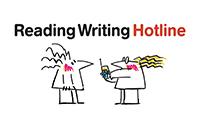This section will give you important information about adult literacy and numeracy in Australia.
Why is it important to know your readers? Because to write effectively we need to understand what our readers will engage with, what they will persevere with, and what they might just ignore. If you want to reach your readers, whether they are customers, staff, or colleagues, read this section.
 43% of Australian adults can find everyday reading and writing challenging2. Using plain language helps them, and it also helps all other adults. Everyone benefits!
43% of Australian adults can find everyday reading and writing challenging2. Using plain language helps them, and it also helps all other adults. Everyone benefits!
What do we know about adult literacy in Australia? #
CASE STUDY
Meet some real people who share their stories
Maree and Tom both share their stories of how they decided to deal with the problems they had in reading, writing and maths – and how this decision has changed their lives. These stories were produced by 26TEN, a literacy service for Tasmanians seeking to improve their literacy skills.
Maree’s Story
Tom’s Story
In Australia we have free education for children, Commonwealth funded literacy classes for people who are looking for work, and an Adult Migrant Education Program for those who want to increase English language skills. So why do we need to think about the way we write?
Here are some statistics that can answer that question for us…
RESEARCH
- 43.7% of the adult population can find everyday reading and writing challenging.2
- 53% of the adult population can find everyday numeracy challenging.2
- Of one million Australian job seekers, approximately 16 per cent (159,000) self-identified with English language needs and/or completed less than year 10 schooling.3
- The Reading Writing Hotline gets more than 4000 calls each year from adults seeking help with reading, writing and numeracy.
- By 2022, The Reading Writing Hotline had over 176 600 calls from adults seeking help with reading, writing and numeracy
- Around 60 percent of Australians have health literacy skills that make it difficult to fully manage their health and wellbeing. Barriers to accessing understanding and using health information include language and literacy.4
- In a 2022 survey, the Australian Council for Adult Literacy found that over two thirds of people who responded knew someone with unmet literacy needs.5
- AI Group research found that most employers believe literacy and numeracy are linked to teamwork and communication and recruitment. They believe they contribute to material wastage and errors, and potential for workplace injuries or unsafe work practices.6
Want to know more?
The Australian Industry Group’s Building Employer Commitment to Workplace Language, Literacy and Numeracy (LLN) Programs project indicate a significant return on investment for employers taking part in workplace LLN programs.
Read more: Ai_Group_Summary_Investigating_in_Workforce_Literacy.pdf (aigroup.com.au)
The AI Group Blog featured workforce retention and the links to LLN programs: Boost retention with opportunities to upskill | AiGroup
What do we mean by adult literacy and numeracy? #
Literacy is what people do with language to communicate, access, produce, use, and discuss information and ideas for social purposes, including in the workplace, home and in the community.
Numeracy is using a combination of literacy, language and mathematical information and ideas to do real world tasks. (Language + literacy + maths = numeracy)
CASE STUDY
What are the challenges adults can face?
Mike and Adam from SBS TV series Lost for Words talk about literacy learning as an adult.
Want to know more?
This presentation is by the Australian Council for Adult Literacy (ACAL) for NPS Medicinewise. It has day to day examples of signs, forms and labels that can be challenging. It also covers Australian statistics. The presentation is about health literacy, but uses everyday examples to help you understand your readers.
Watch here: Adult literacy and health literacy in Australia
You may not realise how much you’re reading words and symbols, and using numbers. Yet for some people these everyday examples might be challenging.
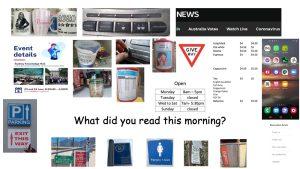
How can I talk about the challenges some adults have with reading and writing?
Please don’t say: Illiterate, innumerate, or having a child’s reading age (eg reads at a 6 year old level).
Better choices are:
- facing literacy or numeracy challenges
- having literacy or numeracy gaps
- unmet literacy needs
- and if you can’t avoid it, low literacy and low numeracy.
Why do the words we use to talk about adult literacy matter? #
Most adults are embarrassed about their literacy gaps. Some have been living with self-doubt and fear of ridicule for much of their lives. They have a wealth of life experiences to draw from and a range of strategies to tackle everyday literacy challenges, but there is a stigma attached to adult literacy that remains.
Want to know more?
The SBS Television series Lost for Words, that aired 2021-22, gives an insight into the lives of successful adults who face some literacy challenges in their workplaces or at home. The student goals illustrate a range of everyday literacy activities that can be challenging. You can watch it on SBS on Demand.
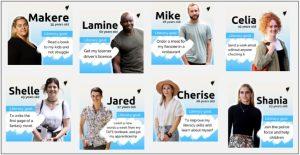
If I know someone with literacy or numeracy gaps what can I do to help them? #
Be respectful, be thoughtful, be kind…
And encourage them to contact the Reading Writing Hotline!
The Reading Writing Hotline has been helping adults since 1994 and is Australia’s national telephone referral service for adult literacy and numeracy. It is funded by the Australian Government. The Hotline hears from many different callers and has an overview of literacy services and needs throughout Australia. If you know someone who is ready to seek some help, tell them about the Hotline.
Contact The Hotline:
Go to the Hotline website: Reading Writing Hotline | Help with reading and writing
or ring 1300 6 555 06.

Want to know more?
Tasmanian organisation 26TEN has information about how to talk to an adult about literacy. Their chat starters can be adjusted to suit anyone. Find them on the 26TEN website under: How to have a 26Ten Chat – 26TenChat
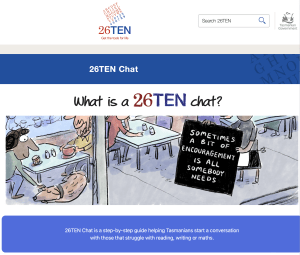
Adult literacy student Mike talks to adult literacy teacher Adam about taking the first step and calling The Reading Writing Hotline. Mike’s advice is “Don’t be ashamed, ring The Hotline, and back yourself!”
Watch here
What can I do as an individual?
The Reading Writing Hotline hears from many people who are surprised by the Australian statistics or moved by the experiences of adults facing literacy barriers. Often they want to get involved and help where they can.
Some ways to take action:
- Volunteer as a literacy tutor – ring the Reading Writing Hotline on 1300 6 555 06 to find out what services are nearby. Helping an adult to improve their literacy is different to helping a child, so do get some training. Adult learning is a professional field and there’s lots of information available.
Information and Advice for Adult Literacy Tutors (readingwritinghotline.edu.au)
- Change the narrative – One of the biggest barriers for adults is caused by the shame they feel. Changing the way society views adult literacy could make a big difference. Be considerate with the way you talk about the issue (see p16: How can I talk about the challenges some adults have with reading and writing?).
Listen to what people have to say and pay attention to their message: Don’t judge people by what their writing looks like (the spelling, the punctuation, the grammar – these are just the surface features).
Want to know more?
The President of the Australian Council for Adult Literacy (ACAL)7 explains:
Taking every opportunity to talk about adult literacy and sharing the issues and possible solutions is something I encourage you all to do. If we can change the attitude of just one person by talking about reducing the stigma and shame we cause as a society by judging adults experiencing literacy challenges there could be a ripple effect. Perhaps that one person goes on to support or encourage one other person who has some amazing things to share, but has not yet found their voice. And perhaps their voice is one that matters!
No action is too small. Each time we remind someone to use kinder words, to pay attention to the message and not the surface features, and to push back on unnecessarily complex and wordy forms and texts, we have the potential to make the world a readable place for all of us.
What can workplaces do for their employees? #
Workplace literacy matters. All workers need reading, writing and maths skills to work safely and comply with standards – on-site, in the field and in the office. Better communication skills improve the way workers understand and follow safety requirements and regulations, and their ability to comply with standards.
Want to know more?
The Reading Writing Hotline website has more information about workplace literacy. The information covers:
- Why workplace literacy matters
- Case studies of workplaces who improved their outcomes by addressing literacy and numeracy demands
Read more on The Reading Writing Hotline website: Benefits for Employers on providing Training – Reading Writing Hotline
There are not many jobs where you don’t need to read or write.
Addressing the literacy demands of the workplace can lead to better morale, better workplace relations, better service, and productivity gains. People in the workplace struggling with their reading may be too embarrassed to ask for help and may silently leave their job, due to shame.
Want to know more?
Watch The Ai Group Centre for Education and Training webinar Literacy, Numeracy and Digital Literacy 101: What employers need to know.
The webinar covers key concepts and discusses strategies to overcome barriers around language, literacy, numeracy and digital literacy in the workplace.
Watch here
Literacy, Numeracy and Digital Literacy 101: What employers need to know | AiGroup
or on VOCEDplus here:
Literacy, Numeracy and Digital Literacy 101: What employers need to know (vimeo.com)
There are two ways workplaces can support their own employees:
- Do an audit of all the reading, writing and numeracy your employees need. Find out if you could change the demands of the workplace to better suit your workforce.
- Support employees to increase their literacy.
Want to know more?
The Ideas That Work series of videos presents key information about literacy and numeracy in workplaces.
This video explains what language, literacy and numeracy means in the workplace:
This video looks at practical ideas for workplaces:
These videos were funded under the Workplace English Language and Literacy (WELL) Program by the Australian Government Department of Education and Training 2015.
CASE STUDY
26TEN Tasmania
In Tasmania the 26TEN program8 has adopted the idea that workplace literacy is everyone’s responsibility. You can read about one of Tasmania’s business success stories on the website:
Want to read more?
How do we do an audit of all the reading, writing and numeracy our employees need?
- Look – Walk through the workplace and look at everything your employees need to read. Take photos to capture all the texts.
- Ask – Talk to your employees. Ask them to show you the things they must read to do their job well. Ask them to show you the things they don’t need to read. If you have a good relationship with the employees and they feel supported, they might tell you what things are challenging to read. They might also tell you what’s missing.
- Do the same with writing needed in the workplace.
- Review – Read the communication that comes from management. Is there…
- too much?
- too little?
- unnecessarily complex language and explanations?
Does management understand how to match their writing to the language and literacy of the employees?
- Seek help – from a language, literacy and numeracy teacher who can both help you with the audit and suggest solutions. Decide what absolutely must be kept and what could be changed to make the workplace easier to succeed in.
- Involve everyone. Make literacy everyone’s business.
CASE STUDY
Ideas that work – Unitywater
Unitywater introduced a workplace-wide training program with help from a literacy and numeracy teacher. They looked at the literacy needs of their processes and adjusted them. For example, they used more symbols rather than words, and changed to easy to use instructions.
This video was funded under the Workplace English Language and Literacy (WELL) Program by the Australian Government Department of Education and Training 2015.
How do we support employees to increase their literacy? #
Support your employees to increase their skills by:
- Supporting their attendance at adult literacy classes
- Running a workplace literacy program
- Training your staff to understand adult literacy needs so they can better support each other and your customers.
- Employing a language, literacy and numeracy teacher to provide professional development.
Want to know more?
Jill is an expert literacy teacher who has taught successful workplace literacy programs. In this video she explains the benefits and how to get started.
Ring the Reading Writing Hotline on 1300 6 555 06 to find out about Government workplace programs and funding. They have current information about programs such as the Skills for Education and Employment (SEE) Program which includes workplace-based training projects.
- For employers, this flexible training can be tailored to meet the specific needs of your business and can be delivered directly to your employees in the workplace at a time convenient to you.
- For industry associations, you can partner with a SEE Provider on behalf of one or more of your members to design a training project for their employees.
- For unions, you can bring together a group of your members to train together. A SEE Provider can partner with you to develop a tailored training project to meet their specific skills needs.
This section is essential reading if you want to reach your customers!
What can our business do to write effectively and have a better chance of reaching our customers? #
To write effectively, you need to understand who you are writing for and adjust your writing to suit them. The first two steps are:
- Review what you know about your customers
- Audit your messaging.
1 How do we review what we know about our customers? #
- Talk to front-line staff. They may have an idea of how your customers respond to your forms, information, signs and other messaging. Provide them with an ongoing feedback system to keep you up-to-date as your processes and/or your customers change.
- Consider the Australian statistics. 43% of Australians can experience barriers when they deal with everyday literacy so you can probably assume that 43% of your customers do too.
- Talk to stakeholders who know your customers, such as the Reading Writing Hotline, organisations you often deal with, and consumer groups.
CASE STUDY
NPS Medicinewise listens to consumers
In 2022, NPS Medicinewise asked consumers to tell them what it’s like to read health information. Hearing from real users is a powerful way to understand your customers.
Shelle spoke about misreading dosage on medication and how easy it can be to mix up amounts, especially when you’re feeling unwell.
CASE STUDY
TAC talks to stakeholders who know their customers
The Western Australian Training Accreditation Council (TAC) reviewed their messaging with the aim of giving clearer information to training organisations. The information was about meeting literacy and learning needs so TAC spoke to three stakeholders who knew the customers and the issues (The Reading Writing Hotline, The Australian Council for Adult Literacy, and The Western Australia Adult Literacy Council).
As a result, TAC created new, easy to follow information sheets and made a podcast where the president of the Western Australia Adult Literacy Council joined them to discuss the issues. TAC also invited all stakeholders to give feedback as part of the website update.
Listen to the podcast
2 How do we audit our messaging? #
- Use the information about adult literacy in Australia that you’ve read in this section to look at your business with fresh eyes. Walk through the business and look at everything your customers need to read and write. Physically walk through if you have buildings or office space and do an online walk-through for your web presence.
- Ask your customers how they feel about your signs, forms, documents, advertising and any other texts you use. Take note of what they like but also be prepared to hear what they don’t like!
- Carry out a formal audit of everything your customers need to read and write.
- Use readability tools as a starting point to understand the complexity of your texts.
- Use tools developed by other organisations that are available online.
CASE STUDY
HelloTAS leads the way with free tools
The HeLLO Tas! Toolkit has been developed collaboratively by the Tasmanian Council of Social Service (TasCOSS), Public Health Services (Tasmanian Government) and Primary Health Tasmania.
About the Toolkit | HeLLO Tas
The toolkit is made by community industry workers for community industry and smaller community health organisations. Many of the ideas could inspire you even if you’re in a different sector – so take a look!
There’s free downloadable resources such as checklists to help you review what you know about your customers and audit your messaging. You can complete these checklists at your own pace, individually or as a group. They include hints to:
- Get customer feedback
- Involve customers
- Develop a workplace culture that supports literacy practices
- Support the literacy of the workforce
- Cater for diverse communities
- Check how customers find your information
- Check how easy it is to understand your communications
- Demonstrate leadership
In the toolkit you will also find:
- Practical tools and resources
- Fact sheets and information to use when you talk to others in your organisation
- Dozens of ideas for how to improve the health literacy of your organisation.
See it on the HelloTas website
Readability tools #
There are many tools you can find online that will give you a measure of how readable your writing is. The tools use different methods, and they can be a good starting place if you are wondering if your texts are reader-friendly. A few common readability tools are:
- SMOG or the Simple Measure Of Gobbledygook
- Flesch Reading Ease
- Gunning Fog Index
- The program you use on your computer may also have tools that help you write more effectively. For example, in Microsoft Word there are tools in the Review section that check spelling, grammar, and accessibility.
Is a readability tool enough? #
If you’ve used a readability tool you might think ‘job done’. However, the tools are often said to aim at a Year 8 level (USA). Even if we could define what a year 8 level really looks like, we know that grade levels don’t describe adult literacy. We also know that many Australian adults will still be challenged by texts approved by a readability tool. The best idea is to use the tool and then do a sense check. Remember what you know about your customers or readers, and think about how you can improve your message. The readability tool is just a first step.
CASE STUDY

A readability tool developed for the health sector
The Sydney Health Literacy Lab has developed a new online health literacy
editor called the SHeLL Editor9. The Editor gives real-time feedback on how easy
texts are to understand. It gives more than just the Grade reading score. It will also point out things like uncommon words, public health jargon (and give alternatives), passive voice, and use of acronyms.
Read more
The aim is always to be more effective in how you reach customers.
These case studies give examples of how organisations have audited their messaging.
CASE STUDY
NPS Medicinewise asked customers and staff for feedback and used tools to audit their messaging.
NPS Medicinewise asked consumers and staff for feedback on their health information. They looked at 50 texts on their website. The consumers were given tools to judge how easy the texts were to understand and act on. The staff used tools to assess the readability.
Then they met at interactive workshops to discuss the findings and come up with solutions to make the information more reader-friendly.
In these presentations, Jemma Gonzalez, Consumer Engagement Lead for NPS Medicinewise, talks about the project. (Press the picture of the speaker on each slide for audio).
Watch here
What-is-health-literacy: https://readingwritinghotline.edu.au/wp-content/uploads/2022/08/What-is-health-literacy.pptx
The-method-NPS-Medicinewise: https://readingwritinghotline.edu.au/wp-content/uploads/2022/08/The-method-NPS-Medicinewise.pptx
Findings-and-recommendations: https://readingwritinghotline.edu.au/wp-content/uploads/2022/08/Findings-and-recommendations.pptx
CASE STUDY

The Sludge-a-thon
The NSW Behavioural Insights Unit runs practical sessions to bust sludge. Government teams from different areas come together for workshops. Each team simplifies one important process from their area. The teams include a range of frontline staff, experts, and managers so there are voices that cover all parts of the customer experience. The teams are supported to understand what isn’t working (the sludge) and why (through a sludge audit). They revise both
the messaging, and the steps customers need to take and then they create more effective and accessible processes. The workshops include information about adult literacy and numeracy in Australia. This understanding is essential for creating communications that are clear, readable, and easy to engage with. The teams are given ongoing support to implement the changes.
Read more
NSW Government Behavioural Insights Unit website: Behavioural Insights Unit | NSW Government
or contact [email protected]
Digital literacy #
For many of us, the online world has made finding information and contacting people easy – everything is at our fingertips. However, digital literacy has become an everyday challenge for some. As information moves online and businesses decrease their in-person service, those who face digital literacy barriers are more and more disadvantaged.
This became very evident during covid pandemic lockdowns. Local services were no longer open. People who usually got help from a teacher, a librarian, a trusted community member, or a friend were isolated.
Even for some people with high literacy, using digital platforms can be difficult because you need reading skills plus technology skills.
Reading Writing Hotline research10 found that when faced with online forms, digital literacy barriers included scanning and uploading documents, having no home computer, not being able to afford data, not being able to access public computers, not having an email address, and having little or no experience using computers.
Research11 shows that around 34% of Australians aged 50 years and over (about 2.7 million people) have either low digital literacy levels or don’t use digital devices or the internet.
When you think about your readers, remember to take digital literacy into account. Ask yourself:
- Can everyone get online?
- Can they easily find my information?
- Can those who do find it read it/fill it in/understand it/take the action I hope for?
CASE STUDY
NPS Medicinewise listens to consumers
In 2022, NPS Medicinewise asked consumers to tell them what it’s like to find information online.
Neville spoke about the long and confusing instructions for doing a covid test at home.
His work-around was to find a video online. However, the next time he wanted to watch, he couldn’t find it again!
Digital literacy can present barriers to locating and using information
Watch here: https://www.youtube.com/watch?v=y6hVUNMRCx0
Numeracy – using maths in adult life #
In Australia, around 53% of adults are challenged by everyday numeracy tasks.2
Maths in everyday life often includes reading, writing, speaking and listening. We call this numeracy, as it is not just maths. It’s the use of language, literacy and mathematical ideas to solve real world problems. You use numeracy skills to pay your bills, manage your money, follow a map, interpret a graph, measure when cooking or buying furniture, to read clothing sizes, and to understand health
information such as medicine dosage.
Do you ask for numerical information? If you ask for dates, ages, phone numbers, or monetary amounts, check that it’s easy for your readers to respond. You can make it easy to respond by:
- Giving examples, such as the date format needed
- Pre-filling information in online forms
- Giving clear guidance on where and how to get help if needed.
If you give information that includes numbers or maths concepts, check that the way you present the information is consistent. For example, always write dates in the same format and write large numbers in a consistent style.
Don’t bury important numbers in too much text because the amount of reading might prevent your readers from finding them easily and quickly. Use layout, size and colour to make your numbers stand out. For example, the Reading Writing Hotline is careful to present their phone number so it’s easy to scan and find. On the landing page they repeat the phone number 5 times so it’s very easy to find.
They also write it with gaps between the numbers that make it easy to read and copy.
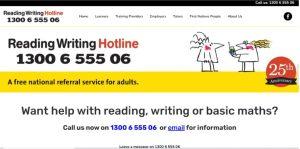
A world written by highly educated or highly literate people can be difficult for others to navigate.
This part of the guide has looked at who might be reading your texts. This was about understanding, or knowing your readers.
You might now be asking:
Am I reaching everyone? Or am I missing 43% of my readers because my messages are too complex?
In the next part we will look at designing texts. You will find out about using simple strategies to make your information quicker and easier to read.
